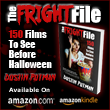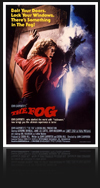All that we see or seem
Is but a dream within a dream.
—Edgar Allan Poe
Mr. Machen:
One hundred years ago on the 21st of April, out in the waters around Spivey Point,
a small clipper ship drew toward land. Suddenly, out of the night, the fog rolled in.
"The Fog" oozes atmosphere from its every pore. With 1978's "
Halloween" a runaway success, there was a mighty bit of pressure for writer-director John Carpenter and co-writer Debra Hill to come up with a zinger follow-up. While audiences and studio execs probably wanted them to do another slasher film—a virtual knock-off of "
Halloween," no doubt—they instead moved in a different genre direction. Set up as a campfire ghost tale in a prologue delivered by storyteller John Houseman, "The Fog" goes the supernatural route. The characters aren't really the point here. The plot isn't, either. No, this picture is first and foremost a classy, expert study in the creation of mood and the power of locations. For ninety minutes, it truthfully feels as if the mist coming out of the sea and toward Antonio Bay is going to also come through one's television or theater screen. The shameful
2005 remake missed the boat on these key attributes, using inferior sets and replacing practical, more convincing effects with lazy CGI that never looked like anything other than CGI.
In the middle of the night, on the eve of Northern California coastal town Antonio Bay's centennial celebration, a mysterious fog bank rolls off the shore just as strange occurrences plague the sleepy community. Car horns go off. Machines in grocery stores act up. Electricity flickers on and off. Out in the ocean, an anchored trawler of sailors witness glowing in the fog, and then an old ship named the
Elizabeth Dane sails by. Before everything goes silent and the fog dissipates, the men are dispatched of by hook-wielding specters. The next day their bodies are discovered, not the most savory of things to happen on a town's milestone anniversary. With preparations for the evening festivities underway—town council head Kathy Williams (Janet Leigh) and sarcastic assistant Sandy (Nancy Loomis) scurry around trying to make sure everything goes off without a hitch—a host of characters, from fisherman Nick Castle (Tom Atkins) and hitchhiking new bedmate Elizabeth Solley (Jamie Lee Curtis), to soft-talking late-night radio deejay Stevie Wayne (Adrienne Barbeau), to Father Malone (Hal Holbrook), receive ominous signs that something strange is afoot. When the fog returns after dark, blanketing the town as Stevie warns her listeners to stay inside and away from it, the vengeance-seeking founders of the town prepare their attack.
 |
They don't, or rarely, make movies like "The Fog" nowadays. The cinematography by Dean Cundey is intoxicating, putting sumptuous use to the anamorphic 2.35:1 widescreen framing, as well as to the eye-popping locations. Shot in and around Inverness, California, the incorporation of the gorgeous Point Reyes Lighthouse (acting as Stevie Wayne's radio station) of particular note, Cundey takes his time and really soaks up the texture and surroundings of where he points his camera. A scene where Stevie Wayne drives her jeep to the lighthouse and makes her way down the steep stairway leading to the station is a delight, not because anything happens, per se, but because of the heavy, lonesome aura it builds. The same goes for the exterior of Father Malone's church, an unorthodox building of worship that holds a weirdly spooky but unquestionable ambiance. The synthesizer-based music score by John Carpenter is sublime, eerie and hard to forget, ideally matching the film's subject matter and tone just as the score for "
Halloween" did.
The pacing is gradual but sure, always building to something, always leading somewhere. Spurts of violence and blood are nonetheless restrained, yet effective. Tensions rise usually from not knowing what could happen—because the villains are spirits, all bets are off—and from Carpenter's terrific mounting of something wicked this way coming. When the fog attacks the town, with Stevie yelling over the radio where it looks to be leading and the rest of the characters trying to outrun it, the viewer believes what he or she is seeing because the effects are not optical. Using fog machines, dry ice, and other common tricks, the title villain actually looks far better here than in the
2005 remake, or in 2007's "
The Mist."
Adrienne Barbeau (who would move on to 1982's "Creepshow") is the quintessential Stevie Wayne, her gentle, smooth voice perfect for the nighttime radio host she is portraying. Save for one scene with her son, Andy (Ty Mitchell), Barbeau is by herself throughout, acting as the other characters' eyes and ears through what she says over the radio, and ultimately commenting on its aftermath. As the male lead, Tom Atkins (1982's "Halloween III: Season of the Witch") is handsome and charismatic as Nick Castle, and he ought to be if we are to believe that he bags hitchhiker Elizabeth minutes after meeting her. As Elizabeth (a far cry from Laurie Strode), Jamie Lee Curtis is headstrong and likable, but underwritten; very little is ever learned about her. The standouts of the supporting cast are Janet Leigh (1960's "
Psycho") and Nancy Loomis (another "
Halloween" alumnus), who share an electric chemistry as bickering councilwoman Kathy and assistant Sandy. "Sandy, you're the only person I know who can make 'Yes, Ma'am' sound like 'Screw you'," Kathy tells her caustic helper at one point. "Yes, Ma'am," Sandy replies. Loomis is a hoot, getting most of the film's best lines.
"The Fog" orchestrates a thick pall of apprehension and good-time suspense as the murderous motives of the ghosts in the fog are uncovered and the climax works itself out. An attack on Stevie at the lighthouse is tautly filmed, as is a set-piece where Andy and his elderly babysitter are accosted in her home by the enveloping stratus clouds. Like any great story to tell around a fire on a chilly night, "The Fog" ends with the portentous notion that it may return. "If this has been anything but a nightmare, and if we don't wake up to find ourselves safe in our beds," Stevie surmises, "it could come again." "The Fog," like the original "
Halloween," is representative of a time when John Carpenter's name meant something. Once upon a time, before his heart and passion stopped being in it, he really was one of the masters of horror.



















